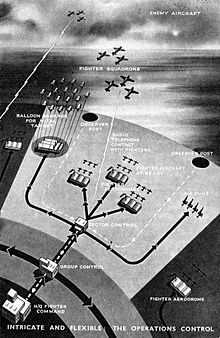My Mothers Sweetheart
Open in another Tab
https://en.wikipedia.org/wiki/Hugh_Dowding,_1st_Baron_Dowding
Dowding system
From Wikipedia, the free encyclopedia
The Dowding system was developed after tests demonstrated problems relaying information to the fighters before it was out of date. Air Chief Marshal Hugh Dowding, commander of RAF Fighter Command, solved the problem through the use of hierarchical reporting chains. Information was sent to Fighter Command Headquarters (FCHQ) central filter room at Bentley Priory and used to prepare a map of the battle. Details of the map were then relayed to the Group and Sector headquarters, where operators re-created the map at a scale covering their area of operations. Looking at the maps, commanders could make decisions on how to employ their forces quickly and without clutter. Instructions were relayed to the pilots only from the squadron's sector control rooms, normally co-located at the fighter's operating bases.
The Dowding system is considered key to the success of the RAF against the German air force (Luftwaffe) during the Battle of Britain. The combination of early detection and rapid dissemination of that information acted as a force multiplier, allowing the fighter force to be used at extremely high rates of effectiveness. In the pre-war period, interception rates of 30% to 50% were considered excellent; that meant that over half the sorties sent out would return without having encountered the enemy. During the Battle, average rates were well over 80%, and several raids were met with 100% success rates.[2] Lacking their own direction system, Luftwaffe fighters had little information on the location of their RAF counterparts, and often returned to base having never seen them. When they did, the RAF fighters were almost always in an advantageous position.
Although many histories of the Battle of Britain comment on the role of radar, it was only in conjunction with the Dowding system that radar could be truly effective. This was not lost on Winston Churchill, who noted that:
All the ascendancy of the Hurricanes and Spitfires would have been fruitless but for this system which had been devised and built before the war. It had been shaped and refined in constant action, and all was now fused together into a most elaborate instrument of war, the like of which existed nowhere in the world.[3]
